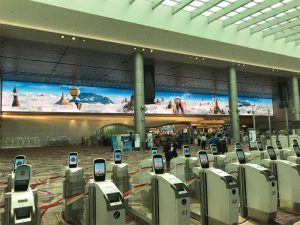
Many displays are used for advertising in addition to their passenger-focused duties, while many advertising-centric displays show information and wayfinding data.
Elevating the customer experience
Since passengers are restricted both in the beginning and at the end of their stay by security lines and departure times respectively, they want to be able to move about autonomously in the spare time they have.
Research experts have noticed a growing trend for ‘self-service’ among customers. Due to the proliferation of servicization and omnichannel selling, consumers have developed an expectation that everything they need should be at their fingertips; when this is not the case, customers sour. Dynamic signage serves as a solution to this problem primarily because customers can see what they need from a distance—not physically at their fingertips, but available immediately nonetheless.
The principal mandate guiding EVIDS and wayfinding signage is to offer passengers what they want in excess, so they can self-navigate. The directions they need are brighter, clearer, more flexible, and more visible when displayed on dynamic signage—whether it is dining options, shopping areas, restrooms, or other airport facilities.
For example, when renovating their International Arrival Customs Terminal, Vancouver International Airport (YVR) made sure passengers were able to access information quickly and easily. Travellers are now met with the sleek, minimalist design of a 9.7- x 2.7-m (32- x 9-ft) LED display welcoming them to the city, which also provides them relevant information about how to proceed from their gate.
Many airports have followed this lead and renovated their gate branding signage to incorporate dynamic LED displays. While a static gate sign can only specify the gate number, a dynamic LED wayfinding blade can display the gate number, flight details, weather, boarding status, and the time—all at once, changing each piece of information as new flights come and go throughout the day. With their questions answered even before they ask, travellers are free to walk around the terminal, especially since they know other displays will likely contain the same information should they need it again. Stress relieved, mood enhanced, and time freed, passengers will likely spend more money when roaming the space.
Augmenting information with entertainment
Along with informing crowds and directing traffic, airports offer other styles of communication to enrich the passenger experience. In environments where crowd flow is accounted for through other means, dynamic signage plays an important role in engaging travellers. Standing in security lines can be frustrating, and dynamic signage offers passengers something to engage with while they wait. For example, a 67- x 5-m (220- x 17-ft) LED display was installed at the security area of an international airport—not so much for the transmission of information, but rather to showcase enthralling visuals from digital storytelling experts.

While a static gate sign can only specify the gate number, a dynamic LED wayfinding blade can display the gate number, flight details, weather, boarding status, and the time—all at once, changing each piece of information as new flights come and go throughout the day.
A medium for culture
The airport environment is the first space a traveller experiences when they arrive in a new city; therefore, it plays an important role in communicating and celebrating the culture of the region it services. Forgettable esthetics remove people from their travel experience and insinuate comparisons between the blandness of the airport and the dullness of the city. Travellers do not just want to be somewhere; they want to feel somewhere, so airports have a duty to create that sense of place for their customers.
Dynamic digital signage can communicate culture in a more dramatic and pragmatic way. For example, ‘The Flower,’ a stunning LED display feature, dominates the central gathering area of Terminal 1 at Toronto Pearson Airport (YYZ), transforming what once was dead space to one of the most highly trafficked locations at the airport. The installation serves the primary purpose of branding the airport with Ontario’s provincial symbol of the white trillium, thereby welcoming passengers into the city’s unique environment and establishing a firm sense of place. That the displays also communicate flight information and weather details to busy travellers is a secondary function, which gives audiences another reason to engage with the artwork.
Some airports use LED signage exclusively for artistic purposes. For instance, a large digital installation at an international airport plays out on three massive LED displays and is a pulsing visual experience, using airport data to influence the constantly regenerating content. The fixture is a fusion of technology, art, and design, and reflects both the interconnected community of the city and its technological ascendance.
Enriching the airport infrastructure
One of the most obvious benefits of dynamic displays is showcasing a wide range of content. While mostly used for EVIDS and wayfinding content, airports can benefit from dynamic signage by selling advertising space to eager retailers. Not only will this help airport facilities to accomplish their primary goal of informing passengers, but generating revenue as well.
Many displays are used for advertising in addition to their passenger-focused duties, while many advertising-centric displays show information and wayfinding data. This versatility increases the value of the display space and the displays themselves.





